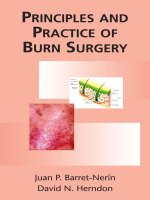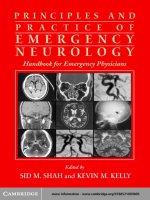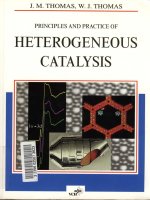Principles and Practice of Emergency Neurology pot
Bạn đang xem bản rút gọn của tài liệu. Xem và tải ngay bản đầy đủ của tài liệu tại đây (14.82 MB, 456 trang )
CY216/Shah-fm CY216/Shah 0521009804 July 14, 2003 12:56 Char Count= 0
vi
This page intentionally left blank
CY216/Shah-fm CY216/Shah 0521009804 July 14, 2003 12:56 Char Count= 0
Principles and Practice of Emergency Neurology
This handbook provides the expertise of the emergency physician–
neurologist editorial team from the acclaimed comprehensive text Emer-
gency Neurology in a readily accessible reference tool for the emergency
department. With a symptom-based emphasis, the text, tables, and illus-
trations guide the emergency physician in the recognition, diagnosis, and
management of neurological disorders both common and complex. Inte-
grating fundamental neurological concepts with the practical realities and
demands of emergency care, this handbook features management algo-
rithms for dozens of conditions and a list of “pearls and pitfalls” at the
conclusion of each of the thirty-eight chapters. This survey of best prac-
tices in emergency neurology provides succinct and crucial clinical infor-
mation for all emergency physicians who diagnose and manage neurologic
disorders such as headache, seizure, and spinal cord injury. Emphasizing
efficient neurological examination techniques, this handbook is essential
for emergency physicians, neurologists, internists, and residents.
Sid M. Shah, M.D., is Assistant Clinical Professor at Michigan State Univer-
sity and a faculty member of Sparrow/MSU Emergency Medicine Residency
Program in Lansing, Michigan, with a special interest in neurological
emergencies. He is an attending emergency medicine physician at Ingham
Regional Medical Center and co-editor of the comprehensive reference,
Emergency Neurology: Principles and Practice (1999).
Kevin M. Kelly, M.D., Ph.D., is Associate Professor of Neurology at Drexel
University College of Medicine. He is an adult neurologist and epileptol-
ogist at Allegheny General Hospital in Pittsburgh, Pennsylvania. He is the
director of coursework in Emergency Neurology and Basic Neuroscience for
residents in the clinical neurosciences and Emergency Medicine, and his
research at the Allegheny-Singer Research Institute focuses on brain aging
and the mechanisms of poststroke epilepsy. He is the co-editor of the com-
prehensive reference, Emergency Neurology: Principles and Practice (1999).
i
CY216/Shah-fm CY216/Shah 0521009804 July 14, 2003 12:56 Char Count= 0
ii
CY216/Shah-fm CY216/Shah 0521009804 July 14, 2003 12:56 Char Count= 0
Principles and Practice of
EMERGENCY NEUROLOGY
Handbook for Emergency Physicians
Edited by
Sid M. Shah
Ingham Regional Medical Center
Michigan State University
Kevin M. Kelly
Allegheny General Hospital
Drexel University College of Medicine
iii
Cambridge, New York, Melbourne, Madrid, Cape Town, Singapore, São Paulo
Cambridge University Press
The Edinburgh Building, Cambridge , United Kingdom
First published in print format
ISBN-13 978-0-521-00980-5 paperback
ISBN-13 978-0-511-06521-7 eBook (NetLibrary)
© Cambridge University Press 2003
2003
Information on this title: www.cambrid
g
e.or
g
/9780521009805
This book is in copyright. Subject to statutory exception and to the provision of
relevant collective licensing agreements, no reproduction of any part may take place
without the written permission of Cambridge University Press.
ISBN-10 0-511-06521-3 eBook (NetLibrary)
ISBN-10 0-521-00980-4 paperback
Cambridge University Press has no responsibility for the persistence or accuracy of
s for external or third-party internet websites referred to in this book, and does not
guarantee that any content on such websites is, or will remain, accurate or appropriate.
Published in the United States by Cambridge University Press, New York
www.cambridge.org
CY216/Shah-fm CY216/Shah 0521009804 July 14, 2003 12:56 Char Count= 0
To my parents Liza and Madhukar Shah
SMS
To my mother Rose and in memory of my father Thomas Kelly
KMK
v
CY216/Shah-fm CY216/Shah 0521009804 July 14, 2003 12:56 Char Count= 0
vi
CY216/Shah-fm CY216/Shah 0521009804 July 14, 2003 12:56 Char Count= 0
Contents
Preface
page xi
Contributors xiii
SECTION I
. NEUROLOGICAL EXAMINATION
AND NEURODIAGNOSTIC TESTING
1 Neurological Examination 1
Thomas F. Scott, M.D., and Sid M. Shah, M.D.
2 Neuroradiology 12
Andrew Goldberg, M.D., and Sid M. Shah, M.D.
3 Electroencephalography 30
Ivo Drury, MB, Bch
4 Lumbar Puncture 35
James Valeriano, M.D., and Daniel Ammons, M.D.
SECTION II. COMMON NEUROLOGICAL PRESENTATIONS
5 Altered Mental Status 43
Lara Kunschner, M.D., and J. Stephen Huff, M.D.
6 Headache 52
Robert Kaniecki, M.D., and Merle L. Diamond, M.D.
7 Weakness 62
George A. Small, M.D., and David M. Chuirazzi, M.D.
8 Dizziness 68
Kevin M. Kelly, M.D., Ph.D., Steven A. Tellan, M.D.,
Moises A. Arriaga, M.D., and Thomas M. Stein, M.D.
9 Seizures 92
Kevin M. Kelly, M.D., Ph.D., and Nicholas Colovos, M.D.
10 Gait Disturbances 109
Jon Brillman, M.D.
vii
CY216/Shah-fm CY216/Shah 0521009804 July 14, 2003 12:56 Char Count= 0
viii Contents
SECTION III. SPECIFIC NEUROLOGICAL CONDITIONS
11 Central Nervous System Infections in Adults 113
Oliver W. Hayes, D.O., Earl J. Reisdorff, M.D., Paul Blackburn,
D.O., and Anthony Briningstool, M.D.
12 Cerebrovascular Disease 131
Michael R. Frankel, M.D., Marc Chimowitz, M.D.,
Sam Josvai, M.D., Rashmi U. Kothari, M.D., and
Sid M. Shah, M.D.
13 Movement Disorders 146
Sid M. Shah, M.D., Roger Albin, M.D., and Susan Baser, M.D.
14 Peripheral Nervous System and Neuromuscular Disorders 161
John Wald, M.D., and James Albers, M.D., Ph.D.
15 Guillain-Barr ´e Syndrome 175
Sandeep Rana, M.D., and Sid M. Shah, M.D.
16 Myasthenia Gravis 180
George A. Small, M.D., and Mara Aloi, M.D.
17 Musculoskeletal and Neurogenic Pain 186
Robert Kaniecki, M.D., and L. R. Searls, D.O.
18 Neuro-Ophthalmological Emergencies 197
Dennis Hanlon, M.D., and Eric R. Eggenberger, D.O.
19 Multiple Sclerosis 210
Thomas F. Scott, M.D.
20 Dementia 218
Judith L. Heidebrink, M.D., and Norman L. Foster, M.D.
21 Brain Tumors and Other Neuro-Oncological Emergencies 226
Herbert B. Newton, M.D.
22 Neuropsychiatry 236
Craig A. Taylor, M.D.
23 Increased Intracranial Pressure and Herniation Syndromes 242
Amy Blasen, D.O., and Sid M. Shah, M.D.
24 Idiopathic Intracranial Hypertension 252
Eric R. Eggenberger, D.O., and Sid M. Shah, M.D.
25 Normal Pressure Hydrocephalus 260
Oliver W. Hayes, D.O., and Lara Kunschner, M.D.
26 Nontraumatic Spinal Cord Emergencies 263
Michael G. Millin, M.D., Sid M. Shah, M.D., and
David G. Wright, M.D.
27 Sleep Disorders 273
A. Sinan Baran, M.D.
SECTION IV
. NEUROLOGICAL TRAUMA
28 Traumatic Brain Injury 279
Chris Carpenter, M.D., Kevin Gingrich, M.D.,
James E. Wilberger, Jr., M.D., Lee Warren, M.D., and Sid M.
Shah, M.D.
CY216/Shah-fm CY216/Shah 0521009804 July 14, 2003 12:56 Char Count= 0
Contents ix
29 Spinal Cord Injury 286
Charles H. Bill II, M.D., Ph.D., and Vanessa L. Harkins, D.O.
30 Peripheral Nerve Injuries and Compression Neuropathies 304
Patricia B. Jozefczyk, M.D., and Mark Baratz, M.D.
SECTION V
.
PEDIATRIC NEUROLOGICAL EMERGENCIES
31 Hydrocephalus and Shunts in Children 313
Stephen Guertin, M.D., and Anthony Briningstool, M.D.
32 Pediatric Infections of the Central Nervous System 325
Anthony Briningstool, M.D., and Jane Turner, M.D.
33 Pediatric Cerebrovascular Disorders 330
Liza A. Squires, M.D., and Imad Jarjour, M.D.
34 Pediatric Seizures 337
Mont R. Roberts, M.D., and Rae R. Hanson, M.D.
35 Hypotonic Infant 350
Marsha D. Rappley, M.D., and Sid M. Shah, M.D.
SECTION VI
. PREGNANCY-RELATED NEUROLOGICAL EMERGENCIES
36 Neurological Emergencies of Pregnancy 359
Mary Hughes, D.O., and Page Pennell, M.D.
SECTION VII
. NEUROTOXICOLOGY
37 Neurotoxicology 371
Fred Harchelroad, M.D., Mary Beth Hines, D.O.,
Janet Eng, D.O., David Overton, M.D., and David Rossi, M.D.
SECTION VIII
. BRAIN DEATH
38 Brain Death 405
David K. Zich, M.D., and Jon Brillman, M.D.
Index 409
CY216/Shah-fm CY216/Shah 0521009804 July 14, 2003 12:56 Char Count= 0
x
CY216/Shah-fm CY216/Shah 0521009804 July 14, 2003 12:56 Char Count= 0
Preface
After the publication of Emergency Neurology: Principles and Practice, many emer-
gency medicine residents inquired whether a handbook based on the main text
would be available. As a result, we developed a handbook to be carried by emer-
gency physicians, extending our initial goal of disseminaing the principles of
emergency neurology to emergency physicians and providing a ready resource
in caring for patients with neurological emergencies. As we embarked upon the
handbook project, we realized that this is a daunting challenge. Providing
the relevant and necessary information in a form that is easily understood and to
the point turned out to be much more difficult than we had anticipated. Brevity is
a challenge when one is expressing complex ideas. As editors we honor the need of
emergency physicians all over the country who work under increasing time con-
straints by trying to provide only the most essential information about a given
topic in a focused manner. Each chapter is extensively updated with timely infor-
mation. As in Emergency Neurology: Principles and Practice, most of the chapters are
authored by a team of an emergency physician and a neurologist. Each chapter
is organized with an introduction of the topic, emergency assessment and clin-
ical findings, pertinent laboratory and radiographic studies, management, and
disposition. Each chapter ends with a list of pearls and pitfalls pertaining to the
topic reviewed.
The handbook is divided into eight sections. Section I contains the essentials
of a focused neurologic examination and neuro diagnostic testing. As editors, we
felt that even though EEG does not directly impact the daily emergency medicine
practice, it is important for the ED physicians to know the importance of an emer-
gent EEG when a condition such as nonconvulsive status epilepticus is suspected.
Common neurological presentations are reviewed in Section II, whereas the spe-
cific neurological conditions are reviewed in Section III. Owing to the importance
of the diagnosis and management issues of Guillain-Barr
´
e syndrome and myas-
thenia gravis, these are now reviewed in two separate chapters. Section IV deals
with the three main components of neurological trauma: traumatic brain injury
and spinal and peripheral nerve injuries. In Section V, those pediatric neurolog-
ical emergencies likely to be encountered in an emergency setting are reviewed.
The chapter on pediatric seizures has been extensively revised. Sections VI and VII
xi
CY216/Shah-fm CY216/Shah 0521009804 July 14, 2003 12:56 Char Count= 0
xii Preface
review pregnancy-related neurological emergencies and selected topics in neuro-
toxicology, respectively. The concluding section is a brief review of brain death.
The editors thank all the authors for their diligence and patience, without
which this handbook would not have been possible. We also thank all our col-
leagues, friends, and emergency medicine and neurology residents for their com-
ments, both critical and encouraging.
CY216/Shah-fm CY216/Shah 0521009804 July 14, 2003 12:56 Char Count= 0
Contributors
James W. Albers, M.D., Ph.D.
Department of Neurology
University of Michigan
Ann Arbor, Michigan
Roger L. Albin, M.D.
Department of Neurology
University of Michigan
Ann Arbor, Michigan
Mara S. Aloi, M.D.
Department of Emergency
Medicine
Allegheny General Hospital
Pittsburgh, Pennsylvania
Daniel M. Ammons, M.D.
Department of Emergency
Medicine
Allegheny General Hospital
Pittsburgh, Pennsylvania
Moises A. Arriaga, M.D.
Department of Neuro-otology
Allegheny General Hospital
Pittsburgh, Pennsylvania
A. Sinan Baran, M.D.
Department of Psychiatry
University of Mississippi
Jackson, Mississippi
Mark E. Baratz, M.D.
Department of Orthopedic
Surgery
Allegheny General Hospital
Pittsburgh, Pennsylvania
Susan M. Baser, M.D.
Department of Neurology
Allegheny General Hospital
Pittsburgh, Pennsylvania
Charles H. Bill II, M.D., Ph.D.
Sparrow Healthcare System
Lansing, Michigan
Paul Blackburn, D.O., FACEP
Maricopa Medical Center
Phoenix, Arizona
Amy Blasen, D.O.
Sparrow Healthcare System
Sparrow Hospital/MSU
Emergency Medicine Residency Program
Lansing, Michigan
Jon Brillman, M.D.
Department of Neurology
Allegheny General Hospital
Pittsburgh, Pennsylvania
Anthony Briningstool, M.D.
Sparrow/MSU
Emergency Medicine Residency Program
Lansing, Michigan
Christopher R. Carpenter, M.D.
Departments of Emergency and Internal
Medicine
Washington University
St. Louis, Missouri
Marc Chimowitz, M.D.
Department of Neurology
Grady Memorial Hospital
Atlanta, Georgia
David M. Chuirazzi, M.D.
Department of Emergency Medicine
Allegheny General Hospital
Pittsburgh, Pennsylvania
Nick E. Colovos, M.D.
Department of Emergency Medicine
xiii
CY216/Shah-fm CY216/Shah 0521009804 July 14, 2003 12:56 Char Count= 0
xiv Contributors
Allegheny General Hospital
Pittsburgh, Pennsylvania
Merle L. Diamond, M.D.
Diamond Headache Clinic
Chicago, Illinois
Ivo Drury, MB, Bch
Department of Neurology
Henry Ford Hospital
Detroit, Michigan
Eric R. Eggenberger, D.O.
Michigan State University
East Lansing, Michigan
Janet Eng, D.O.
Ingham Regional Medical Center
Sparrow Hospital/MSU
Emergency Medicine Residency
Program
Lansing, Michigan
Norman L. Foster, M.D.
Department of Neurology
University of Michigan
Ann Arbor, Michigan
Michael R. Frankel, M.D.
Department of Neurology
Grady Memorial Hospital
Atlanta, Georgia
Kevin J. Gingrich, M.D.
Department of Anesthesiology
Thomas Jefferson University
Philadelphia, Pennsylvania
Andrew L. Goldberg, M.D.
Medical Director
Westside Imaging Center
Brook Park, Ohio
Stephen Guertin, M.D.
Sparrow Healthcare System
Lansing, Michigan
Dennis P. Hanlon, M.D.
Department of Emergency Medicine
Allegheny General Hospital
Pittsburgh, Pennsylvania
Rae R. Hanson, M.D.
Midelfort Clinic
Eau Claire, Wisconsin
Fred Harchelroad, M.D.
Department of Emergency Medicine
Allegheny General Hospital
Pittsburgh, Pennsylvania
Vanessa L. Harkins, D.O.
Sparrow Healthcare System
Sparrow Hospital/MSU
Emergency Medicine Residency Program
Lansing, Michigan
Oliver W. Hayes, D.O.
Ingham Regional Medical Center
Sparrow Hospital/MSU
Emergency Medicine Residency Program
Lansing, Michigan
Judith L. Heidebrink, M.D.
Department of Neurology
University of Michigan
Ann Arbor, Michigan
Mary Beth Hines, D.O.
Keweenaw Memorial Medical Center
Laurium, Michigan
J. Stephen Huff, M.D.
University of Virginia Health Systems
Charlottesville, Virginia
Mary Hughes, D.O.
Sparrow Healthcare System
Ingham Regional Medical Center
Sparrow Hospital/MSU
Emergency Medicine Residency
Program
Lansing, Michigan
Imad T. Jarjour, M.D.
Department of Pediatrics and
Neurology
Allegheny General Hospital
Pittsburgh, Pennsylvania
Sam Josvai, M.D.
Kalamazoo Center for Medical Studies/
MSU Emergency Medicine Residency
Program
Kalamazoo, Michigan
Patricia B. Jozefczyk, M.D.
Department of Neurology
Allegheny General Hospital
Pittsburgh, Pennsylvania
Robert G. Kaniecki, M.D.
Department of Neurology
University of Pittsburgh
Pittsburgh, Pennsylvania
Kevin M. Kelly, M.D., Ph.D.
Department of Neurology
Allegheny General Hospital
Pittsburgh, Pennsylvania
CY216/Shah-fm CY216/Shah 0521009804 July 14, 2003 12:56 Char Count= 0
Contributors xv
Rashmi U. Kothari, M.D.
Kalamazoo Center for Medical Studies/
MSU Emergency Medicine Residency
Program
Kalamazoo, Michigan
Lara J. Kunschner, M.D.
Department of Neurology
Allegheny General Hospital
Pittsburgh, Pennsylvania
Michael G. Millin, M.D.
Oregon Health Sciences University
Portland, Oregon
Herbert B. Newton, M.D.
Department of Neurology
Ohio State University
Columbus, Ohio
David Overton, M.D.
Kalamazoo Center for Medical Studies/
MSU Emergency Medicine Residency
Program
Kalamazoo, Michigan
Page B. Pennell, M.D.
Department of Neurology
Emory University
Atlanta, Georgia
Sandeep S. Rana, M.D.
Department of Neurology
Allegheny General Hospital
Pittsburgh, Pennsylvania
Marsha D. Rappley, M.D.
Michigan State University
East Lansing, Michigan
Earl J. Reisdorff, M.D.
Ingham Regional Medical Center
Sparrow Hospital/MSU
Emergency Medicine Residency Program
Lansing, Michigan
Mont R. Roberts, M.D.
Sparrow Healthcare System
Sparow Hospital/MSU
Emergency Medicine Residency Program
Lansing, Michigan
David Rossi, M.D.
Kalamazoo Center for Medical Studies/
MSU Emergency Medicine Residency
Program
Kalamazoo, Michigan
Thomas F. Scott, M.D.
Department of Neurology
Allegheny General Hospital
Pittsburgh, Pennsylvania
L. R. Searls, D.O.
Ingham Regional Medical Center
Sparrow Hospital/MSU
Emergency Medicine Residency Program
Lansing, Michigan
Sid M. Shah, M.D.
Ingham Regional Medical Center
Sparrow Hospital/MSU
Emergency Medicine Residency Program
Lansing, Michigan
George A. Small, M.D.
Department of Neurology
Allegheny General Hospital
Pittsburgh, Pennsylvania
Liza A. Squires, M.D.
Devos Childrens Hospital
Grand Rapids, Michigan
Thomas M. Stein, M.D.
Department of Emergency Medicine
Allegheny General Hospital
Pittsburgh, Pennsylvania
Craig A. Taylor, M.D.
Southwood Psychiatric Hospital
Pittsburgh, Pennsylvania
Steven A. Tellan, M.D.
Department of Otolaryngology
University of Michigan
Ann Arbor, Michigan
Jane Turner, M.D.
Michigan State University
East Lansing, Michigan
James P. Valeriano, M.D.
Department of Neurology
Allegheny General Hospital
Pittsburgh, Pennsylvania
John J. Wald, M.D.
Department of Neurology
University of Michigan
Ann Arbor, Michigan
W. Lee Warren, M.D.
Department of Neurology
Wildford Hall Air Force Medical Center
San Antonio, Texas
James E. Wilberger, Jr., M.D.
Department of Neurology
CY216/Shah-fm CY216/Shah 0521009804 July 14, 2003 12:56 Char Count= 0
xvi Contributors
Allegheny General Hospital
Pittsburgh, Pennsylvania
David G. Wright, M.D.
Department of Neurology
Pittsburgh, Pennsylvania
David K. Zich, M.D.
Department of Emergency and Internal
Medicine
Northwestern University
Chicago, Illinois
CY216-01 CY216/Shah 0521009804 May 22, 2003 11:7 Char Count= 0
SECTION I. NEUROLOGICAL EXAMINATION AND
NEURODIAGNOSTIC TESTING
1
Neurological Examination
Thomas F. Scott and Sid M. Shah
INTRODUCTION
The neurological history and examination provide information to help localize le-
sions of the nervous system. The neurological examination is incorporated in the
context of the patient’s overall health history and general physical examination.
Evidence of systemic disease is considered in the interpretation of the neurological
findings.
Goals of an emergency neurological examination:
1. Is there a neurological condition?
2. Where is (are) the lesion(s) located?
3. What are the possible causes?
4. Can the patient be discharged safely from the emergency department or is
hospitalization required?
Neurological History
A detailed neurological history allows one to focus on important components of
the neurological examination, thus saving time and resources. The more specific
and detailed a history, the greater is the likelihood of making a definite diagnosis
in the emergency department. About 75% of neurological diagnoses are made
from the history alone. An account from family members and bystanders can be
an important source of information. A detailed description of the event is more
important than the patient or a bystander volunteering a diagnosis such as “I had
a seizure.” The history obtained from the patient can be considered a part of the
mental status examination.
Important Historical Elements of a Focused Neurological Examination
1. Onset of symptoms: time and mode (Look beyond the symptoms, to the con-
text in which they occur.)
2. Temporal relationships of symptoms
1
CY216-01 CY216/Shah 0521009804 May 22, 2003 11:7 Char Count= 0
2 Scott and Shah
Table 1.1. The Brief Mental Status Examination
Score
Item Number of errors × Weight = Total
What year is it now? 0 or 1 × 4 =
What month is it? 0 or 1 × 3 =
Present memory phrase: “Repeat this
phrase after me and remember it: John
Brown, 42 Market Street, New York.”
About what time is it?
(Answer correct if within one hour)
0or1 × 3 =
Count backwards from 20 to 1. 0, 1, or 2 × 2 =
Say the months in reverse. 0, 1, or 2 × 2 =
Repeat memory phrase (Each underlined
portion is worth 1 point.)
0, 1, 2, 3, 4, or 5 × 2 =
Final score is the sum of the total =
Possible score range, from 0 to 28. 0–8 normal; 9–19 mildly impaired; 20–28 severely impaired.
Source: Kaufman DM, Zun L. A quantifiable, brief mental status examination for emergency
patients. J Emerg Med. 1995;13:449–56.
3. Progression of symptoms
4. Associated symptoms (neurological and nonneurological)
5. Exacerbating and alleviating factors
6. Symptoms that indicate involvement of a particular region of central nervous
system
7. History of similar event
8. History of medication use: illicit drug use, exposure to toxins, head trauma
Neurological Examination
Mental status
Cranial nerve function
Motor function
Deep tendon reflexes, cutaneous reflexes, and miscellaneous signs
Sensory modalities
Pathological reflexes
Mental Status
See Table 1.1.
Six elements of mental status evaluation, modified from Zun and Howes
(1988), are:
1. Appearance, behavior, and attitude
Is dress appropriate?
Is motor behavior at rest appropriate?
Is the speech pattern normal?
2. Disorders of thought
Are the thoughts logical and realistic?
Are false beliefs or delusions present?
Are suicidal or homicidal thoughts present?
CY216-01 CY216/Shah 0521009804 May 22, 2003 11:7 Char Count= 0
Neurological Examination 3
Table 1.2. Glasgow Coma Scale
Eye opening
Opens eyes spontaneously 4
Opens eyes to verbal command 3
Opens eyes to pain 2
Does not open eyes 1
Verbal response
Alert and oriented 5
Converses but disoriented 4
Speaking but nonsensical 3
Moans or makes unintelligible sounds 2
No response 1
Motor response
Follows commands 6
Localizes pain 5
Movement or withdrawal from pain 4
Abnormal flexion (decorticate) 3
Abnormal extension (decerebrate) 2
No response 1
Total 3–15
3. Disorders of perception
Are hallucinations present?
4. Mood and affect
What is the prevailing mood?
Is the emotional content appropriate for the setting?
5. Insight and judgment
Does the patient understand the circumstances surrounding the visit?
6. Sensorium and intelligence
Is the level of consciousness normal?
Is cognition or intellectual functioning impaired?
The Glasgow Coma Scale is often used as a method of briefly quantitating
neurological dysfunction (see Table 1.2).
More specific testing of higher cortical functions is often added to the men-
tal status examination in patients with evidence of focal lesions. Delineation of
aphasias can involve detailed testing but is usually limited to gross observation of
speech output, conduction (ability to repeat), and comprehension. Other tests in-
clude naming objects, distinguishing between right and left, and testing for visual
and sensory neglect (especially important in parietal and thalamic lesions).
Cranial Nerve Function
Evaluating the Cranial Nerves
➤I. Olfactory
Evaluate: Smell
Anatomic Location: Olfactory bulb and tract
CY216-01 CY216/Shah 0521009804 May 22, 2003 11:7 Char Count= 0
4 Scott and Shah
Tests: Odor recognition
Significant Findings: Lack of odor perception in one or both sides
Lesions of the olfactory groove (typically meningioma) can have associated psychiatric
symptoms related to frontal lobe injury.
➤II. Optic
Evaluate: Vision
Anatomic Location: Optic nerve, chiasma, and tracts
Tests: Visual acuity
Significant Findings: Reduced vision
Tests: Pupillary light reflex
Significant Findings: Afferent pupillary defect (Marcus-Gunn pupil +/−)
Tests: Visual field testing
Testing visual acuity is important when primarily ocular lesion(s) are suspected.
Papilledema: increased intracranial pressure due to tumor, hydrocephalus, or other
causes. Hollenhorst plaque: a bright-appearing cholesterol or atheromatous embolus
visualized by funduscopic examination of the retinal vessels, implies an embolic process.
Optic nerve lesions: monocular visual disturbance.
See comment 1.
➤III. Oculomotor
Evaluate: Eye movement, pupil contraction and accommodation, eyelid elevation
Anatomic Location: Midbrain
Tests: Extraocular eye movements (EOM)
Significant Findings: Impairment of one or more eye movements or disconjugate
gaze
Tests: Pupillary light reflex
Significant Findings: Pupillary dilatation, ptosis
Cranial nerves III, IV, VI – Check for EOM.
Dysfunction of these nerves can be localized by noting the direction of gaze, which
causes or worsens a diplopia, and any loss of upgaze, downgaze, or horizontal move-
ments in either eye. Diplopia that worsens on lateral gaze suggests an ipsilateral palsy
of cranial nerve VI or lateral rectus weakness.
See comment 2.
➤IV. Trochlear
Evaluate: Eye movement
Anatomic Location: Midbrain
Tests: Extraocular eye movements
Significant Findings: Impairment of one or more eye movements or disconjugate
gaze
➤V. Trigeminal
Evaluate: Facial sensation, mastication
Anatomic Location: Pons
CY216-01 CY216/Shah 0521009804 May 22, 2003 11:7 Char Count= 0
Neurological Examination 5
Tests: Sensation above eye, between eye and mouth, below the mouth to angle
of jaw
Significant Findings: Reduced sensation in one or divisions of cranial nerve V
Tests: Corneal reflex
Significant Findings: Impaired
Tests: Palpation of masseter muscles
Significant Findings: Reduced strength in masseter or pterygoid muscles
If an abnormality is found in only one or two divisions of cranial nerve V (V
1
–V
3
),
the findings imply a lesion distal to the gasserian ganglion.
See comment 3.
➤VI. Abducens
Evaluate: Ocular movement
Anatomic Location: Pons
Tests: Extraocular eye movements
Significant Findings: Reduced eye abduction
➤VII. Facial
Evaluate: Facial expression secretions, taste, visceral and cutaneous sensibility
Anatomic Location: Pons
Tests: Facial expression
Significant Findings: Weakness of upper or lower face or eye closure
Tests: Corneal reflex
Significant Findings: Impaired
Tests: Taste on anterior
2
3
tongue
Significant Findings: Impaired
Seventh cranial nerve lesions can be either central or peripheral. In central lesions,
located proximal to the seventh nerve nucleus and contralateral to the resulting facial
droop, the upper face (periorbital area and forehead) will be relatively spared. The
palpebral fissure may be slightly larger ipsilateral to the facial droop. In peripheral
lesions, weakness is ipsilateral to the lesion of the seventh cranial nerve nucleus or
the nerve itself. Other brainstem signs are seen typically when a lesion involves
the nerve nucleus; the term Bell’s palsy commonly refers to lesions of the nerve distal
to the nucleus. Eye closure may be lost in severe cases of peripheral seventh
nerve lesions. Hyperacusis is due to loss of the seventh nerve’s dampening influence on
the stapes.
➤VIII. Acoustic
Evaluate: Hearing, equilibrium
Anatomic Location: Pons
Tests: Auditory and vestibular
Significant Findings: Reduced hearing
The eighth cranial nerve consists of an auditory component and a vestibular component.
Deafness rarely results from cortical lesions, which more often cause difficulty with
CY216-01 CY216/Shah 0521009804 May 22, 2003 11:7 Char Count= 0
6 Scott and Shah
sound localization. Common bedside testing involves comparison for gross symmetry
with a high-pitched tuning fork (512 or 256 Hz) or by finger rubbing near the ear, and
the Weber and Rinne tests (for air conduction compared to bone conduction of sound).
Lesions of the vestibular nuclei and the vestibular portion of the eighth cranial nerve can
produce vertigo, nausea, vomiting, and nystagmus.
➤IX. Glossopharyngeal
Evaluate: Taste, glandular secretions, swallowing, visceral sensibility (pharynx,
tongue, tonsils)
Anatomic Location: Medulla
Tests: Gag reflex
Significant Findings: Reduced gag
Tests: Speech (phonation)
Significant Findings: Dysarthria
Tests: Swallowing
Significant Findings: Dysarthria
Lesions of cranial nerve IX may be undetected clinically.
➤X. Vagus
Evaluate: Involuntary muscle and gland control (pharynx, larynx, trachea, bronchi,
lungs, digestive system, heart), swallowing, phonation, visceral and cutaneous
sensibility, taste
Anatomic Location: Medulla
Tests: Phonation
Significant Findings: Hoarseness
Tests: Coughing
Significant Findings: Impaired
Hoarseness and dysphagia can be seen with unilateral or bilateral injury to cranial
nerve X.
➤XI. Accessory
Evaluate: Movement of head and shoulders
Anatomic Location: Cervical
Tests: Resisted head turning
Significant Findings: Weakness of trapezius and sternocleidomastoid muscle
The loss of strength is often greater with nuclear or peripheral lesions as opposed to a
supranuclear injury of cranial nerve XI.
➤XII. Hypoglossal
Evaluate: Tongue movement
Anatomic Location: Medulla
Tests: Tongue protrusion
CY216-01 CY216/Shah 0521009804 May 22, 2003 11:7 Char Count= 0
Neurological Examination 7
Significant Findings: Deviation, atrophy of tongue, fasciculations of tongue
On protrusion, a unilateral weak tongue deviates toward the side of weakness in lesions
of the nucleus and peripheral nerve injury, but away from supranuclear lesions. Nuclear
and peripheral lesions are associated with atrophy when chronic.
Comment 1. Visual field defects include (a) homonymous hemianopsia, a large hemi-
spheric lesion or lesion of the lateral geniculate ganglion, (b) bitemporal hemianopsia,
a lesion of the pituitary area compressing the optic chiasm, (c) central scotoma, a
lesion of the optic nerve that typically occurs with optic neuritis, (d) superior quad-
rantanopsia, a contralateral temporal lobe lesion.
The pupillary light reflex includes the swinging flashlight test that may reveal a
consensual response (contralateral pupillary constriction with stimulation) despite a
relatively poor direct response ipsilaterally (afferent pupillary defect, also known as
a Marcus-Gunn pupil) due to an optic nerve lesion.
Bilateral pinpoint pupils in a comatose patient with apneustic or agonal respira-
tions imply a pontine lesion or a narcotics overdose. Loss of the oculocephalic reflex,
or “doll’s eyes,” is rarely seen in drug overdose and implies brainstem injury (normally,
eye movements are opposite to rotary movements of the head performed by the ex-
aminer). A unilateral dilated pupil in a comatose patient implies brainstem herniation,
usually related to contralateral hemispheric mass effect. Bilateral dilated and fixed
pupils and loss of all brainstem reflexes and respiratory drive occur in brain death.
Paralytic agents can produce a similar clinical presentation, but typically pupils are
not affected.
Comment 2. Cranial nerve III and sympathetic fibers are responsible for eye opening;
consequently, ptosis, without or with a Horner’s syndrome (ptosis, miosis, anhidro-
sis), is recorded as part of the extraocular muscle examination (although the pupil
abnormalities associated with these syndromes can be recorded as part of the visual
examination). A classic finding of abnormal ocular motility is referred to as an inter-
nuclear ophthalmoplegia (INO). See Chapter 18, “Neuro-Ophthalmological Emergen-
cies,”for definition of INO. Abnormal ipsilateral adduction with visual tracking of the
eye is seen with lacunar infarcts of the medial longitudinal fasciculus (MLF) or with
multiple sclerosis plaques in the MLF.
Comment 3. Distinct splitting of sensory function at the midline face can imply a func-
tional disorder. Vibration is not tested for cranial nerve V function, but splitting of
vibratory sensation across the forehead or skull is further evidence of a functional
component in a clinical presentation.
Motor Function
Tone and Power
Muscle tone is evaluated by passively moving joints through a range of mo-
tion at varying velocities. Rigidity occurs in extrapyramidal disorders such as
Parkinson’s disease. Tremor plus rigidity yields “cogwheel” rigidity. Muscle tone
can be increased in both pyramidal and extrapyramidal disturbances. Acute cen-
tral nervous system (CNS) lesions involving the pyramidal tracts often produce
hypotonia. This finding evolves over days, producing hyperreflexia and hy-
pertonicity, referred to as spasticity. Hypertonicity can occur acutely in brain-
stem lesions (decorticate or decerebrate posturing). Hypotonicity may be present
chronically in neuromuscular disease.









